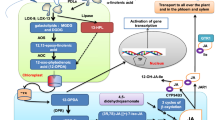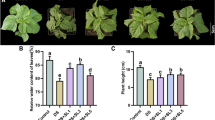Abstract
The effects of combined treatment with an elicitor (lipopolysaccharide) and a signaling molecule (salicylic acid) on the disease resistance of wild-type (Col-0) and mutant Arabidopsis thaliana L. plants have been compared. The mutant lines used were jin1 (with impaired jasmonate signaling), npr1 (lacking expression of pathogen-dependent PR genes), and NahG (expressing an active bacterial salicylate hydroxylase transgene). The lipopolysaccharide was isolated from a saprophytic strain (8614) of Pseudomonas aeruginosa bacteria. Treatment of A. thaliana seeds with a composite preparation (lipopolysaccharide and salicylic acid–SA) increased the resistance of seedlings to a subsequent infection by the pathogenic 9096 strain of P. aeruginosa bacteria. The protective effect was more pronounced in jin1 mutant seedlings, which was indicative of the possible compensation of jasmonate signaling impairment due to activation of the SA-dependent signaling pathway. We concluded that a preparation composed of an elicitor and a signaling molecule could affect regulatory mechanism functioning in a plant cell and, in particular, compensate for the absence of a certain signaling pathway by activating another.
Similar content being viewed by others
Change history
24 July 2018
Page 170, right column, the first sentence of the last paragraph should read:
References
Dyakov, Yu.T., Population Biology of Phytopathogenic Fungi, Moscow: Muravei, 1998.
Dmitriev, A.P., Signalling molecules for activation of plant defense reactions in response to biotic stress, Russ. J. Plant Physiol., 2003, vol. 50, no. 3, pp. 1–10.
Ozeretskovskaya, O.L., Vasyukova, N.I., Panina, Ya.S., and Chalenko, G.I., Effect of immunomodulators on potato resistance and susceptibility to Phytophthora infestans, Russ. J. Plant Physiol., 2006, vol. 53, no. 4, pp. 488–494.
Polyakovsky, S.A., Kravchuk, Zh.N., and Dmitriev, A.P., The mechanisms of action of plant resistance inductors by the example of Allium cepa, Tsitol. Genet., 2008, vol. 42, no. 6, pp. 8–12.
Zhuk, I.V., Lisova, G.M., Dovgal, Z.M., and Dmitriev, A.P., The induction of Triticum aestivum L. tolerance to Septoria tritici by oxalic acid, Modern Phytomorphology, 2014, vol. 6, pp. 105–108.
Tyuterev, S.L., Ecologically safe inducers of plant resistance to diseases and physiological stresses, Plant Protection News, 2015, vol. 1, no. 83, pp. 3–13.
Dmitriev, A.P., Kovbasenko, R.V., Avdeyeva, L.V., Lapa, S.V., and Kovbasenko, V.M., Signal Systems of Plants and Formation of Resistance to Biotic Stress, Kiev: Phoenix, 2015.
Dow, M., Newman, M.A., and von Roepenack, E., The induction and modulation of plant defense responses by bacterial lipopolysaccharides, Annu. Rev. Phytopathol., 2000, vol. 38, pp. 241–261.
Newman, M.A., Dow, J.M., Molinaro, A., and Parrilli, M., Priming, induction and modulation of plant defense responses by bacterial lipopolysaccharides, J. Endotoxin Res., 2007, vol. 13, no. 2, pp. 68–79.
Mishina, T.E. and Zeier, J., Pathogen-associated molecular pattern recognition rather than development of tissue necrosis contributes to bacterial induction of systemic acquired resistance in Arabidopsis, Plant J., 2007, vol. 50, no. 3, pp. 500–513.
Caarls, L., Pieterse, C.M., and Van Wees, S.C., How salicylic acid takes transcriptional control over jasmonic acid signaling, Front. Plant Sci., 2015, vol. 6, p. 170.
Thaler, J.S., Humphrey, P.T., and Whiteman, N.K., Evolution of jasmonate and salicylate signal crosstalk, Trends Plant Sci., 2012, vol. 17, no. 5, pp. 260–270.
Loake, G. and Grant, M., Salicylic acid in plant defense—the players and protagonists, Curr. Opin. Plant Biol., 2007, vol. 10, no. 5, pp. 466–472.
Shilina, J.V., Guscha, M.I., Molozhava, O.S., Litvinov, S.V., and Dmitriev, A.P., Role of salicylate and jasmonate signaling in lipopolysaccharide-induced resistance of Arabidopsis thaliana to the phytopathogenic strain of Pseudomonas aeruginosa IMB 9096, Visn. Ukr. Tov. Genet. Sel., 2015, vol. 13, no. 1, pp. 100–104.
Zhuk, I.V., Lisova, G.M., and Dmitriev, A.P., Effects of oxalic acid and sodium nitroprusside on productivity and resistance of winter wheat to Septoria leaf blotch and leaf rust infections, Visn. Kharkiv. Nat. Univ. Ser. Biol., 2017, vol. 41, no. 2, pp. 68–77.
Spoel, S.H., Koornneef, A., Claessens, S.M., Korzelius, J.P., Van Pelt, J.A., Mueller, M.J., Buchala, A.J., Metraux, J.P., Brown, R., Kazan, K., Van Loon, L.C., Dong, X., and Pieterse, C.M., NPR1 modulates crosstalk between salicylate-and jasmonate-dependent defense pathways through a novel function in the cytosol, Plant Cell, 2003, vol. 15, no. 3, pp. 760–770.
Doares, S.H., Syrovets, T., Weller, E.W., and Ryan, C.A., Oligogalacturonides and chitosan activate plant defensive genes through the octadecanoid pathway, Proc. Natl. Acad. Sci. U. S. A., 1995, vol. 92, no. 10, pp. 4095–4098.
Jia, X., Meng, Q., Zeng, H., Wang, W., and Yin, H., Chitosan oligosaccharide induces resistance to tobacco mosaic virus in Arabidopsis via the salicylic acid-mediated signalling pathway, Sci. Rep., 2016, vol. 6. doi 10.1038/srep26144
Ryabchinskaya, T.A., Bobreshova, I.Yu., Kharchenko, G.L., and Sarantseva, N.A., Remote aftereffect of treatment with phytoactivators for subsequent reproduction of spring barley, in Modern Immunological Studies: Materials of Scientific-Practica. Conf., Bolsye Vyazemy, 2009, pp. 173–179.
Lykova, N.A., The Effect of Preheating. Environmental Aftereffects, St. Petersburg: Nauka, 2009.
Guscha, M.I., Shilina, J.V., and Dmitriev, A.P., Transgenerational transmission of adaptive effects to UV-B irradiation in Arabidopsis thaliana plants, in Vii Congress on Radiation Research, Abstracts of Reports, Moscow, 2014, pp. 207–208.
Author information
Authors and Affiliations
Corresponding author
Additional information
Original Ukrainian Text © J.V. Shilina, M.I. Gushcha, O.S. Molozhava, S.V. Litvinov, A.P. Dmitriev, 2018, published in Tsitologiya i Genetika, 2018, Vol. 52, No. 3, pp. 3–8.
About this article
Cite this article
Shilina, J.V., Gushcha, M.I., Molozhava, O.S. et al. Induction of Arabidopsis thaliana Resistance to Pathogenic Bacteria by Lipopolysaccharide and Salicylic Acid. Cytol. Genet. 52, 169–173 (2018). https://doi.org/10.3103/S0095452718030118
Received:
Published:
Issue Date:
DOI: https://doi.org/10.3103/S0095452718030118




